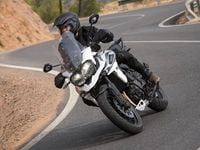This whole ADV craze has been going on long enough that it's about time I finally bought in. While I've understood the hypothetical appeal of ADV bikes, until I spent two days riding the 2018 Triumph Tiger 1200 XCA in Spain, I didn't fully comprehend how their "best of all worlds" intentions actually translated to all-roads bliss.
It's ironic that it wasn't a "superbike in dirt bike clothes" kind of bike, like the BMW S1000XR or Ducati Multistrada, that opened my eyes to ADV charms. The Tiger 1200 definitely skews to the touring side. Previous models have been accused of hanging on to the coattails of BMW's R1200GS, but for 2018, the Tiger's myriad updates mean it can hold its own. If you're in the market for a large-displacement, premium ADV bike, the Tiger 1200 deserves a look.
Growing up as a race fan, sportbikes have always been the bikes I’m most attracted to, even though I acknowledge that they aren’t the most practical choice for the road. For me, riding a motorcycle isn’t about practicality or rationality, so I can readily justify the associated sacrifice of comfort and ride quality that a sportbike demands. Because they’re uncompromising, they provide an undiluted sensory experience—their handling is the most dynamic, their power delivery the most thrilling. Riding a race-bred motorcycle on the road is like going on a date with a girl way out of your league, or standing on a mountain summit looking across miles of uninhabited wilderness. There’s something “beyond yourself” about the whole thing.
I like physically small, light bikes. ADV bikes are big, heavy, unwieldy. My Ducati 899 Panigale, for instance, has a claimed dry weight of 373 pounds; the 2018 Triumph Tiger 1200 XCA went on a diet to get down to 534 pounds. In the past, I’ve avoided even swinging a leg over big ADV bikes at dealerships. There are few things more emasculating than turning red in the face from the effort of hoicking a motorcycle off its sidestand.
I’ve always appreciated from afar the touring capability of ADV bikes but have taken umbrage at their off-road pretenses. How many GS riders actually take their bikes off pavement? It seems like a major sacrifice to ride an extra tall motorcycle just so it can theoretically go someplace the rider never (or very rarely) goes. More than that, when I look at an ADV bike, I see compromise.
Riding the big Triumph had me rethinking ADV bikes and arguing with myself in my helmet: “You can’t possibly like this bike this much! You’re a sportbike guy, Richards! What, are you getting old and soft? What’s next, pleated Dockers and New Balances?”
Before the existential crises ensued, I was mostly concerned with not dropping the thing at a stop sign, so I immediately put the seat in the lower of its two positions. It’s a straightforward process that involves moving two bars beneath the seat; it takes all of one minute. In spite of its substantial weight, the Tiger 1200 XCA was easy to get off its sidestand. You won’t have to fear looking like a weakling when you throw your leg over it at your local dealership. With motocross-inspired boots on, I could pretty well plant my feet flat on the ground. For shorter riders, Triumph’s low ride-height version sports a seat height as low as 31.1 inches.
On the road, the Triumph carried its weight well. The wide bars made dipping and swaying the bike through the corners a treat. I made a game of seeing how many consecutive corners in which I could perfectly clip the apex (I lost count). Being a stranger to the roads, I exercised a lot of caution (proof that even sportbike riders can mature), so my lean angles were nothing to brag about, but I can easily imagine putting the Tiger through its paces on my favorite local twisties. That said, unlike on a sportbike, which goads the rider into a spirited pace, the Tiger is just as amenable to going at a leisurely clip, allowing the rider to take in the surroundings and simply enjoy the act of riding. No pretenses here.
The long-travel suspension is great at handling rough roads, such as the ones I ride in Upstate New York where frost heave has wreaked havoc on the asphalt, creating fault line-like fractures more befitting of a topographical map than a scenic state route. The Tiger’s TSAS (Triumph Semi Active Suspension) is a game changer, automatically setting preload to rider/passenger/luggage weight and changing damping on the fly for a ride quality that’s superior to that of any bike I’ve yet ridden.
The promise of sore knees and the lack of luggage capacity contracts the radius of travel on a sportbike. On the Tiger, my body raised upright and my eyes lifted to the horizon, the road stretches out in front of me, and the journey no longer becomes limited by comfort or practical concerns. Throw a pair of knobbies on the Tiger and there are even more roads to traverse, more ways to let it surprise you with its capabilities, and more excuses to go for a ride. One motorcycle can provide, well, more motorcycling.
Yes, the Triumph Tiger 1200 XCA is heavy and perhaps it’s not as characterful or as exciting as a sportbike, but it takes the transcendent, logic-defying allure of motorcycling and expands its usefulness and accessibility. If sportbikes are uncompromising in their single-minded pursuit of performance, ADV bikes are uncompromising in their pursuit of redeeming all times and all places for riding a motorcycle. Or maybe I’m just getting old.















/cloudfront-us-east-1.images.arcpublishing.com/octane/TNOU5DNE2BC57MFPMGN2EIDXAM.jpg)
/cloudfront-us-east-1.images.arcpublishing.com/octane/GTCXACQGJ5HAPDTGWUQKDEH44E.jpg)
/cloudfront-us-east-1.images.arcpublishing.com/octane/S35YGSEMEZB4BLTDJTSZPF4GLA.jpg)
/cloudfront-us-east-1.images.arcpublishing.com/octane/5UOT6HPX2JFMRJAX6EH45AR4MQ.jpg)
/cloudfront-us-east-1.images.arcpublishing.com/octane/OKWOJWAKP5EP3OACCRRWPCIX2Q.jpg)
/cloudfront-us-east-1.images.arcpublishing.com/octane/2WF3SCE3NFBQXLDNJM7KMXA45E.jpg)
/cloudfront-us-east-1.images.arcpublishing.com/octane/G4MG6OUCJNBSHIS2MVVOTPX65E.jpg)
/cloudfront-us-east-1.images.arcpublishing.com/octane/IIGGWFOTOJGB7DB6DGBXCCMTDY.jpg)
/cloudfront-us-east-1.images.arcpublishing.com/octane/QSTCM6AVEZA5JJBUXNIQ3DSOF4.jpg)
/cloudfront-us-east-1.images.arcpublishing.com/octane/U4I7G625B5DMLF2DVIJDFZVV6M.jpg)
/cloudfront-us-east-1.images.arcpublishing.com/octane/B6XD6LS6IVCQPIU6HXDJSM3FHY.jpg)
/cloudfront-us-east-1.images.arcpublishing.com/octane/ICL63FEDDRDTTMINYICCEYGMDA.jpg)
/cloudfront-us-east-1.images.arcpublishing.com/octane/FCGZHQXRBZFLBAPC5SDIQLVF4I.jpg)
/cloudfront-us-east-1.images.arcpublishing.com/octane/WNOB6LDOIFFHJKPSVIWDYUGOPM.jpg)

/cloudfront-us-east-1.images.arcpublishing.com/octane/X33NU3E525ECRHXLNUJN2FTRKI.jpg)
/cloudfront-us-east-1.images.arcpublishing.com/octane/6KKT5NNL2JAVBOXMZYS5ZO76YA.jpg)
/cloudfront-us-east-1.images.arcpublishing.com/octane/J5RKG5O455GMPGQRF2OG6LRT7A.jpg)
/cloudfront-us-east-1.images.arcpublishing.com/octane/GX2CIZKQVRH2TATDM26KFG2DAE.jpg)
/cloudfront-us-east-1.images.arcpublishing.com/octane/ZWIDYSAKQZHD5BHREMQILXJCGM.jpg)
/cloudfront-us-east-1.images.arcpublishing.com/octane/CYUHJZCTSJCH3MRAQEIKXK7SCQ.jpg)
/cloudfront-us-east-1.images.arcpublishing.com/octane/LKOFINY56FCXJCANJ5M7ZDQUBY.jpg)
/cloudfront-us-east-1.images.arcpublishing.com/octane/4NBPDACMWJH63JQYJVK3QRBDZI.jpg)
/cloudfront-us-east-1.images.arcpublishing.com/octane/KKHQHRR3FJGX7H2IPU6RALMWG4.jpg)